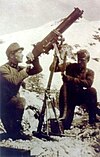Frommer Stop
| Frommer Stop | |
|---|---|
 Frommer Stop in caliber 7.65mm Browning | |
| Type | Semi-automatic pistol Machine pistol |
| Place of origin | Austria-Hungary |
| Service history | |
| Used by | Austro-Hungarian Army Royal Hungarian Army Ottoman Army |
| Wars | World War I World War II |
| Production history | |
| Designed | 1912 |
| Manufacturer | Fegyver- és Gépgyár |
| Produced | 1912–45 |
| Variants | Pisztoly 12M Pisztoly 19M Pisztoly 39M |
| Specifications | |
| Mass | 610 g (22 oz) |
| Length | 165 mm (6.5 in) |
| Barrel length | 95 millimeters (3.7 in) Fegyver- és Gépgyár |
| Cartridge | 7.65mm 9mm Kurz |
| Action | Recoil-operated |
| Rate of fire | Semi-automatic |
| Muzzle velocity | 280 m/s (919 ft/s) |
| Feed system | 7-round detachable box magazine 25 round detachable box magazine (Prototype submachinegun) |
The Frommer Stop is a Hungarian semi-automatic pistol which was manufactured by small arms firm Fegyver- és Gépgyár (FÉG) in Budapest. It was designed by Rudolf Frommer and adopted by the Austro-Hungarian Army in 1912 as the Pisztoly 12M. The pistol was manufactured in various forms from 1912 to 1945 and was also used by the Ottoman Army and the Royal Hungarian Army, seeing action in World War I and World War II. It's design features a 165 millimeters (6.5 in) long with a 95 millimeters (3.7 in) 4-groove rifled barrel. Unloaded weight is 610 g (22 oz), and the detachable box magazine holds seven rounds.[1]
The pistol incorporated design features of Frommer's earlier sidearm designs, including the M1901 and M1904, both of which were inspired by the Roth–Theodorovic pistol.[2] A predecessor to the M1911, the Frommer Stop was chambered in a proprietary 7.65mm cartridge which had a crimp in the shell casing at the base of the bullet. This round achieved a velocity of 920 feet per second (280 m/s) from the gun. After creating the pistol's first design, Frommer redesigned it with a more conventional layout and patented it in 1912. The new variant was produced from 1919 to 1939, and was adopted by the Royal Hungarian Army under the name Pisztoly 19M and saw service during World War II. The last variant of the Frommer Stop, the Pisztoly 39M, was produced in 9mm Kurz, though it was never adopted as a service pistol by any nation.[1]
Machine pistol variant[edit]
Beginning in 1916, the Austro-Hungarians made several attempts to replicate the Italian Villar Perosa aircraft submachine gun. In 1917, FÉG converted two Frommer Stop pistols into automatic machine pistols with 25-round magazines and fitted them side-by-side to a central mount with a tripod. The machine-pistols were mounted upside-down, and the magazine catches were enlarged for easier unloading. The triggers were removed, and the guns were operated by a set of rods connecting to the spade grips of the mount, which directly engaged the sears. The barrels were lengthened and the cocking mechanisms were redesigned as protruding arms, which were engaged by a set of hinged retracting levers.[3][4]
This submachine gun was designed to be used as a light machine gun like the Villar Perosa. Although it was tested by the Austro-Hungarian Army, it was not successful and was only made in small numbers. The Frommer machine-pistol was succeeded later in 1917 by the more successful Sturmpistole, a direct copy of the Villar Perosa.[5]
Users[edit]
See also[edit]
References[edit]
- ^ a b Broten, Merv. "Frommer Baby and Stop Pistols". cruffler.com. Retrieved 26 September 2017.
- ^ Antaris, Leonardo M. (2017). "In the Beginning". American Rifleman. 165 (10). National Rifle Association of America: 80.
- ^ Ortner, M. Christian (2006). Storm Troops: Austro-Hungarian Assault Units and Commandos in the First World War: Tactics, Organisation, Uniforms and Equipment. Vienna: Militaria Verlag. ISBN 9783950164282. OCLC 63197175.
- ^ "Frommer M.17". firearms.96.lt. Retrieved 2023-06-15.
- ^ "Frommer M.17". firearms.96.lt. Retrieved 2023-06-15.

